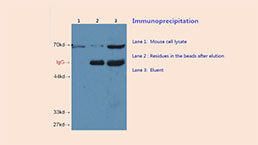Polyclonal Antibody to Pepsin (PP)
- Product No.PAA632Hu01
- Organism SpeciesHomo sapiens (Human) Same name, Different species.
- SourcePolyclonal antibody preparation
- HostRabbit
- Potencyn/a
- Ig Type IgG
- PurificationAntigen-specific affinity chromatography followed by Protein A affinity chromatography
- LabelNone
- Immunogen NPA632Hu01-Native Pepsin (PP)
- Buffer Formulation0.01M PBS, pH7.4, containing 0.05% Proclin-300, 50% glycerol.
- TraitsLiquid
- Concentration0.5mg/mL
- Organism Species MoreSus scrofa; Porcine (Pig)
- ApplicationsWB; IHC
If the antibody is used in flow cytometry, please check FCM antibodies. - DownloadInstruction Manual
- UOM 20µl100µl 200µl 1ml 10ml
- FOB
US$ 95
US$ 221
US$ 316
US$ 790
US$ 3160
For more details, please contact local distributors!
SPECIFITY
The antibody is a rabbit polyclonal antibody raised against PP. It has been selected for its ability to recognize PP in immunohistochemical staining and western blotting.
USAGE
Western blotting: 0.01-2µg/mL;
Immunohistochemistry: 5-20µg/mL;
Optimal working dilutions must be determined by end user.
STORAGE
Store at 4°C for frequent use. Stored at -20°C in a manual defrost freezer for two year without detectable loss of activity. Avoid repeated freeze-thaw cycles.
STABILITY
The thermal stability is described by the loss rate. The loss rate was determined by accelerated thermal degradation test, that is, incubate the protein at 37°C for 48h, and no obvious degradation and precipitation were observed. The loss rate is less than 5% within the expiration date under appropriate storage condition.
GIVEAWAYS
INCREMENT SERVICES
| Magazine | Citations |
| Radiology and Oncology | LEVEL OF PEPSIN AND BILE ACIDS IN THE SALIVA OF PATIENTS WITH GLOTTIS T1 CARCINOMA Szd:Source |
| Radiology and Oncology | Higher levels of total pepsin and bile acids in the saliva as a possible risk factor for early laryngeal cancer Pubmed:Pmc4362607 |
| Clin Otolaryngol | Pepsin and bile acids in saliva in patients with laryngopharyngeal reflux – a prospective comparative study PubMed: 25516364 |
| journal of pediatric gastroenterology and nutrition | Does Positioning Affect Tracheal Aspiration of Gastric Content in Ventilated Infants? PubMed: 25313850 |
| Journal of Voice | Detecting Laryngopharyngeal Reflux by Immunohistochemistry of Pepsin in the Biopsies of Vocal Fold Leukoplakia pubmed:28756936 |
| Sensors (Basel) | Label-Free Detection of Salivary Pepsin Using Gold Nanoparticle/Polypyrrole Nanocoral Modified Screen-Printed Electrode Pubmed:29882917 |
| The Tohoku Journal of Experimental Medicine | Association between Pepsin in Bronchoalveolar Lavage Fluid and Prognosis of Chronic Fibrosing Interstitial Lung Disease |
| Respiratory Research | Pulmonary aspiration in preschool children with cystic fibrosis Pubmed: 30558606 |
| Tanaffos | Association of Bile Acid and Pepsin Micro-aspiration with Chronic Obstructive Pulmonary Disease Exacerbation Pubmed: 31423141 |
| Sensors | Optimization of Saliva Collection and Immunochromatographic Detection of Salivary Pepsin for Point-of-Care Testing of Laryngopharyngeal Reflux Pubmed: 31935973 |
| BIOSCIENCE REPORTS | Presence of pepsin in laryngeal tissue and saliva in benign and malignant neoplasms Pubmed: 33103719 |
| OTOLARYNGOLOGY-HEAD AND NECK SURGERY | Relationship Between Pepsin Expression and Dysplasia Grade in Patients With Vocal Cord Leukoplakia Pubmed: 32692278 |
| American Journal of Otolaryngology | Association of pepsin and DNA damage in laryngopharyngeal reflux-related vocal fold polyps Pubmed: 32889371 |
| The relationship between laryngopharyngeal reflux based on pepsin value and clinical characteristics of laryngeal cancer patients | |
| Med Sci Monit | The Role of Salivary Pepsin in the Diagnosis of Gastroesophageal Reflux Disease (GERD) Evaluated Using High-Resolution Manometry and 24-Hour?¡ 33220027 |
| Annals of Esophagus | Pepsin properties, structure, and its accurate measurement: a narrative review |
| Laryngoscope | The Impact of Laryngopharyngeal Reflux on Occurrence and Clinical Course of Recurrent Respiratory Papillomatosis 34338331 |
| Pulmonology | Bronchoalveolar lavage (BAL) amylase and pepsin levels as potential biomarkers of aspiration pneumonia Pubmed:35715334 |
| Neuromodulation: Technology at the Neural Interface | Transcutaneous Electrical Acustimulation Improved the Quality of Life in Patients With Diarrhea-Irritable Bowel Syndrome Pubmed:35088760 |
| Catalog No. | Related products for research use of Homo sapiens (Human) Organism species | Applications (RESEARCH USE ONLY!) |
| NPA632Hu01 | Native Pepsin (PP) | Positive Control; Immunogen; SDS-PAGE; WB. |
| CPA632Hu21 | OVA Conjugated Pepsin (PP) | Immunogen; SDS-PAGE; WB. |
| CPA632Hu23 | OVA Conjugated Pepsin (PP) | Immunogen; SDS-PAGE; WB. |
| CPA632Hu22 | OVA Conjugated Pepsin (PP) | Immunogen; SDS-PAGE; WB. |
| PAA632Hu02 | Polyclonal Antibody to Pepsin (PP) | WB |
| PAA632Hu08 | Polyclonal Antibody to Pepsin (PP) | WB; IHC; ICC; IP. |
| PAA632Hu01 | Polyclonal Antibody to Pepsin (PP) | WB; IHC |
| PAA632Hu09 | Polyclonal Antibody to Pepsin (PP) | WB; IHC; ICC; IP. |
| LAA632Hu71 | Biotin-Linked Polyclonal Antibody to Pepsin (PP) | WB; IHC; ICC. |
| MAA632Hu22 | Monoclonal Antibody to Pepsin (PP) | WB; IHC |
| SEA632Hu | ELISA Kit for Pepsin (PP) | Enzyme-linked immunosorbent assay for Antigen Detection. |
| CEA632Hu | ELISA Kit for Pepsin (PP) | Enzyme-linked immunosorbent assay for Antigen Detection. |
| IEA632Hu | Instant ELISA Kit for Pepsin (PP) | Enzyme-linked immunosorbent assay for Antigen Detection. |
| LMA632Hu | Multiplex Assay Kit for Pepsin (PP) ,etc. by FLIA (Flow Luminescence Immunoassay) | FLIA Kit for Antigen Detection. |
| KSA632Hu11 | ELISA Kit DIY Materials for Pepsin (PP) | Main materials for "Do It (ELISA Kit) Yourself". |


















